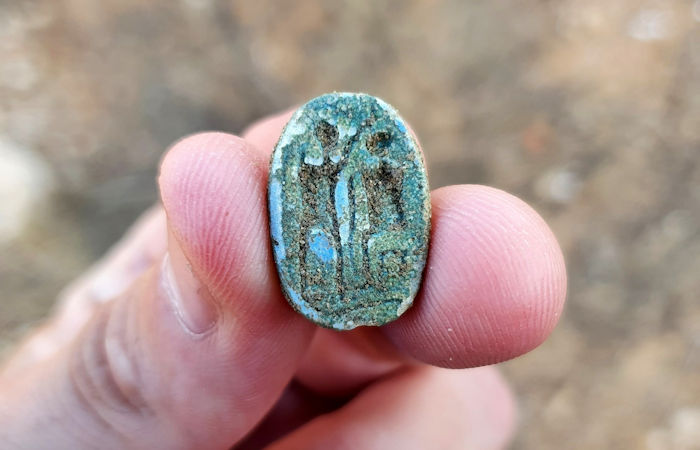Jan Bartek – AncientPages.com – A well-preserved 3,000-year-old scarab seal was accidentally discovered during a school trip in Israel. The ancient Egyptian stone amulet depicts the bestowal of legitimacy to a ruler.
The ancient amulet and impression seal was discovered during a school field trip to Azor, about seven kilometers southeast of Tel Aviv, Israel.

A 3,000-year-old scarab discovered during a school field trip to Azor, located southeast of Tel Aviv, Israel. Credit: Gilad Stern/Israel Antiquities Authority.
“We were walking around when I spotted something that looked like a tiny toy on the ground,” said Gilead Stern of the Israel Antiquity Authority Educational Center, who was leading a school group on an archaeological tour.
“An inner voice said to me: ‘Pick it up and turn it over.’ I was astonished: it was a scarab seal with a clearly incised scene, the dream of every amateur archaeologist! The pupils were really excited!”
As previously explained on AncientPages.com the “scarab is one of the oldest and widely used symbols of the ancient Egyptians. Egyptian pharaohs worshipped dung beetles, and most probably, it was symbolically as sacred to the Egyptians as the cross is to Christians.
The scarabs with aesthetic qualities and shamanic symbolism were already known in the Old Kingdom (3rd millennium BC) and played an important role in the early worship of animals. It is supported by archaeological evidence discovered in graves during the time of King Den of Dynasty I.”
The ancient amulet found by the schoolchildren shows the scarab was carved in the form of the common dung beetle. The ancient Egyptians envisioned the activity of the beetle, rolling a ball of dung twice its size, to store its future offspring as the embodiment of creation and regeneration, similar to the act of the Creator God.’
“The scarab was used as a seal and was a symbol of power and status. It may have been placed on a necklace or a ring. It is made of faience, a silicate material coated with a bluish-green glaze.
It may have dropped from the hands of an important figure of authority who pᴀssed through the area, or it may have been deliberately buried in the ground along with other objects, and after thousands of years it came to the surface,” Golani said.
“This scene basically reflects the geopolitical reality that prevailed in the land of Canaan during the Late Bronze Age (ca. 1500-1000 BCE), when the local Canaanite rulers lived (and sometimes rebelled) under Egyptian political and cultural hegemony. Therefore, it is very possible that the seal is indeed from the Late Bronze Age, when the local Canaanites were ruled by the Egyptian Empire,” he added.
The tour of the eighth-grade pupils from the Rabin Middle School, took place in the context of a Tour-Guide Course organized by the Israel Antiquity Authority, for the third year running. The course enables the pupils to learn and then teach the local residents of Azor about their local archaeological heritage.
See also: More Archaeology News
According to Eli Escusido, Director of the Israel Antiquity Authority, “Finding the scarab during a field tour with pupils participating in the Tour-Guide course, is symbolic, in that the pupils were gaining archaeological knowledge, and at the same time contributing to our archaeological heritage. This cooperation is really significant, as we are working towards connecting communities with their cultural heritage.”
Written by Jan Bartek – AncientPages.com Staff Writer





